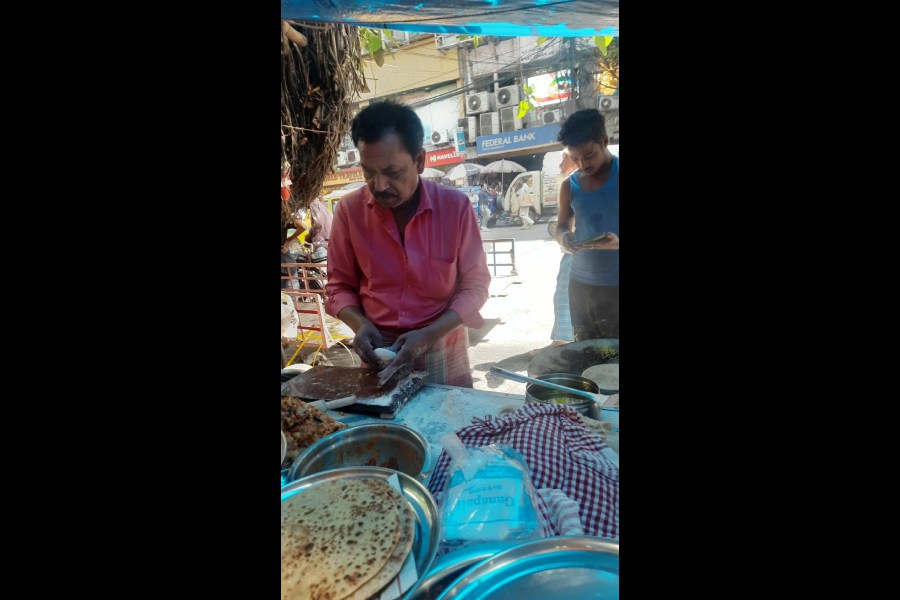Char hath-roti dena. Garam, garam.” A woman’s shrill voice cuts sharply through the surroundings. “I bring along the tarkari from home but I buy the rotis from here,” says Soma Mondal, who works in a shop on Ezra Street in central Calcutta.
Rajen Prasad Singh’s roti shop is at a street crossing. Anyone who has seen the place would know it is one of the busiest spots in these parts. For one, this is where the “light bazaar” is — fairy lights and lampshades peep out of every shop. Then there are plywood godowns, cycle shops, wholesalers dealing in tea, shops selling electrical accessories and wires. Labourers, thelawalas, cycles loaded with boxes, rickshaw pullers, mini vans keep interrupting the flow of traffic. “There is hardly any place for anyone to stand and eat,” says Singh. “Lekin khana to khayega... But eat one must. Most of my customers are regulars,” he adds.
Singh opens his shop by eight in the morning and starts serving breakfast. “Most shops around are yet to open but there are coolies who have to leave for work to Howrah Station or Burrabazar or Sealdah’s Baithakkhana bazaar, or there are coolies who are returning after a night’s work.”
At 8am the city is still stirring awake. It is still shutters down at the showrooms in this neighbourhood. The jhalmuri stall won’t open until mid-morning. The owner of the kachori-singhara-jalebi shop next door is still on the cleaning up; only the chaiwala in the same line is up and doing brisk business — the smallest bhnaar at his shop is called kuli cha or a shot of tea.
“You cannot always eat kachori. But you can have roti any time of the day,” Singh says. He too owns a kachori shop on Bentinck Street. He adds, “It is a very old shop, which my father started in the 1950s. But it is this shop that earns the bread for my family of seven, not that one.”
“Iska locasion hi aisa hai (sic)…” says Singh; such is its location. This is a market area. Apart from the labourers, those populating the area are shopkeepers, shop assistants, taxi drivers, dealers, retailers and loaders.
The 19-year-old, who is a roti karigar in Singh’s shop, keeps rolling one roti after another. He tosses one into the fire, flips it with his bare hands and transfers a batch of 10 into a casserole. Another karigar, who is in his 30s, piles the parathas. Together they use up 40-50 kilograms of flour every day. “Four rotis and sabzi or two parathas and sabzi cost Rs 30. It is filling, it keeps you going for the next few hours,” says Singh, who has three karigars working for him. “I make rotis when I have to relieve one of them, at other times I serve the customers. How else will we manage to work till 5pm?”
Singh had never planned to make rotis for a living. He hadn’t planned anything at all. When he was a teenager, he was sent to Patna to train under a goldsmith, a Bengali karigar.
Singh’s grandfather had left Patna for Calcutta in 1911. His father was born in Patna but he started his professional life in Calcutta, with a place on Bentinck Street and opened a tea stall. That was in the 1950s. A tea stall was not as commonplace then as it is now and, as Singh tells it, his father was most likely the only chaiwala within a kilometre or two.
After three years of working with a sunar, Singh became an apprentice to a Muslim johri. “He was an expert in stone settings. He taught me all about diamonds, panna, chuni. For seven years, I worked with him.”
But familial pressure and increasing workload forced him to come back to Calcutta. That was in the early 1980s. He says, “I started working in my father’s shop. It was during those days that I came across an Odia karigar. He used to make fabulous chhilkawala aloo sabzi and urad dal ki kachori. I have never tasted anything so delicious.” He adds, “He would sell four kachoris for one rupee.”
Singh decided to start a shop with him. He continues, “I used to observe him keenly — how soft the dough should be, how much water, how hot the oven should be and how to keep the rotis soft and hot for hours.”
But in a city where rice is the staple, making a success of a roti shop was not easy, especially in them days. He says, “I had to find the right location. And this was it. Almost on the threshold of Burrabazar. Poddar Court, teeming with offices, is close by. This is where Gujaratis, Marwaris, Biharis, Punjabis, Scindhis and Jats came together in pursuit of their livelihoods. It is not the typical Bengali neighbourhood. To date, a rice shop is at least half a kilometre away from my shop.”
He continues, “A plate of rice comes for Rs 60-70. Do you think people who barely make Rs 100 a day will spend half the money on one meal? My Odia guru told me to stick to making rotis and I took his word for it.”
And so, Singh came to make his rozi by roti instead of by gold. And from the looks of
it, he is happy doing so. He gazes up at the sky and says with a flourish — “Khanewala khilata bhi hai…”











